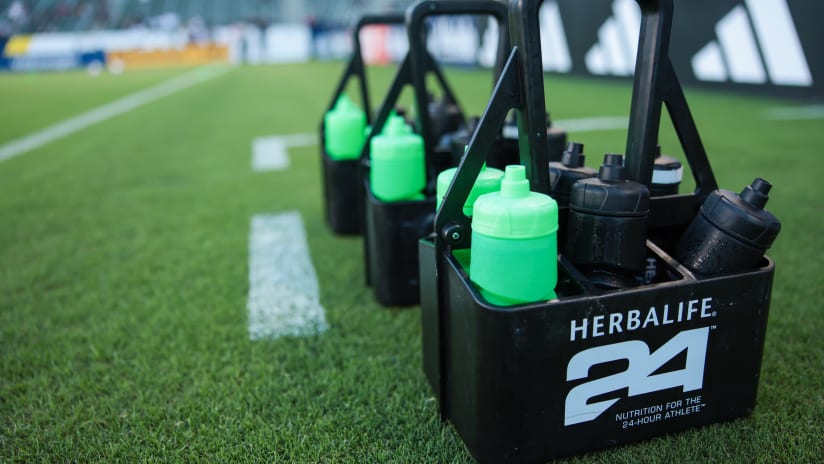Herbalife is the sports nutrition and presenting partner for the LA Galaxy. Herbalife Dietitians work closely with the LA Galaxy technical staff to make sure we are maximizing their nutrition to support performance goals.
In this article, I will discuss the various common micronutrient deficiencies that can manifest in female athletes.
Micronutrient deficiencies
There are a handful of common micronutrient deficiencies among female athletes. These include deficiencies in iron, vitamin D, calcium, zinc, B vitamins, and magnesium.
Iron1-3
Due to monthly menstruation, women of reproductive age are more likely to become iron-deficient than men. This is especially important for female athletes, as iron is one of the key performance nutrients, and iron deficiency can be extremely detrimental to both performance and overall health.
- Role in performance: red blood cell production, oxygen delivery to working tissues, energy production, muscle function
- Deficiency symptoms: low red blood cells, fatigue, poor mood, decreased aerobic capacity, increased rate of perceived exertion, shorter time to exhaustion
- Food sources: lean meat, poultry, fish, eggs, beans and lentils, tofu, whole grains, leafy greens, fortified cereals/pastas
- Consume iron-rich foods with vitamin C-rich foods to increase absorption
- High-fiber foods, calcium, tea, coffee, and cocoa - all reduce absorption
Vitamin D1-4
Vitamin D insufficiency and deficiency are extremely common in the United States. For female athletes, this can cause performance detriments.
- Role in performance: maintains bone health, aids in immunity, repair, and recovery, enhances explosive muscle movements, jump height, velocity, and power
- Deficiency symptoms: low bone density, stress fractures, fatigue, muscle and joint pain, poor immunity, and frequent illness
- Food sources: salmon, tuna, mushrooms, egg yolk, milk, soymilk, fortified orange juice, fortified cereals
- Vitamin D is a hormone! Sunshine exposure is key for vitamin D production within the skin
Calcium1-3
Another common deficiency in female athletes is calcium. This is especially important as female athletes have special considerations when it comes to bone health, and calcium is one of the key components of bone mineralization.
- Role in performance: maintains nervous function, promotes insulin sensitivity, regulates muscle contraction/relaxation, promotes bone health, signals hormone secretion, helps maintain normal blood pressure, regulates heart rhythm
- Deficiency symptoms: muscle cramps and spasms, weak/brittle nails, fatigue, numbness or tingling in extremities, difficulty breathing during exercise, easy fracturing, confusion, and difficulty concentrating
- Food sources: dairy products, tofu, beans, lentils, chickpeas, flaxseeds, chia seeds, Brazil nuts, hazelnut, Tahini, sardines, broccoli, leafy greens
- Vitamins D and K act synergistically to increase calcium absorption in the gut!
Zinc2,3,5
When athletes sweat, zinc is one of many nutrients that is lost. Further, zinc can be depleted in athletes because it helps combat the oxidative stress induced by heavy training.
- Role in performance: cellular respiration and energy production, antioxidant properties, aids in protein and muscle building, plays a role in bone health, wound healing, boosts immunity
- Deficiency symptoms: decreased appetite, low energy levels, decreased endurance, risk of osteoporosis
- Food sources: seafood, chicken, fortified cereals, dairy products, beans, nuts, oatmeal
B Vitamins2,3,6
B vitamins are required for and used in energy production and many other physiological processes, leaving athletes at risk of deficiency when coupled with a poor diet or low energy availability.
- Role in performance: promotes red blood cell production and increased oxygen carrying capacity, cellular health and energy production, promotes brain and nervous function, plays a role in cardiovascular health, enhanced blood flow, growth hormone production
- Deficiency symptoms: fatigue, weakness, vision problems, headaches, indigestion, loss of appetite, shortness of breath, dizziness, numbness, and tingling
- Food sources: eggs, lean meats, fish, dairy products, fortified cereals, whole grains
Magnesium2,3
Magnesium is another one of the nutrients in which the vast majority of the US population is deficient. Stress on the body accumulating from intense training regimens can further deplete magnesium levels in the body of female athletes.
- Role in performance: cognitive function, muscle contraction/relaxation, muscle growth, energy production, sleep/recovery, cardiorespiratory function, bone health, stress reduction
- Deficiency symptoms: fatigue, poor bone health, abnormal heart rhythm, mood changes, muscle cramps
- Food sources: nuts, seeds, leafy greens, soymilk, legumes, peanut butter, whole wheat, avocado, brown rice, yogurt, oatmeal, bananas, milk
The next segment of this series will cover carbs and protein for female athletes.
References
1. Holtzman B, Ackerman KE. Recommendations and nutritional considerations for female athletes: Health and performance. Sports Med. 2021;51(Suppl 1):43-57. doi:10.1007/s40279-021-01508-8
2. Gastrich MD, Quick V, Bachmann G, Moriarty AM. Nutritional risks among female athletes. J Womens Health (Larchmt). 2020;29(5):693-702. doi:10.1089/jwh.2019.8180
3. Thomas DT, Erdman KA, Burke LM. Position of the academy of nutrition and dietetics, dietitians of Canada, and the American college of sports medicine: Nutrition and athletic performance. J Acad Nutr Diet. 2016;116(3):501-528. doi:10.1016/j.jand.2015.12.006
4. Cui A, Xiao P, Ma Y, et al. Prevalence, trend, and predictor analyses of vitamin D deficiency in the US population, 2001-2018. Front Nutr. 2022;9:965376. Published 2022 Oct 3. doi:10.3389/fnut.2022.965376
5. Micheletti A, Rossi R, Rufini S. Zinc status in athletes: relation to diet and exercise. Sports Med. 2001;31(8):577-582. doi:10.2165/00007256-200131080-00002
6. Woolf K, Manore MM. B-vitamins and exercise: does exercise alter requirements?. Int J Sport Nutr Exerc Metab. 2006;16(5):453-484. doi:10.1123/ijsnem.16.5.453




